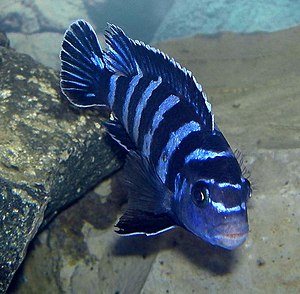Chindongo demasoni
| Chindongo demasoni | ||||||||||||
|---|---|---|---|---|---|---|---|---|---|---|---|---|

Chindongo demasoni |
||||||||||||
| Systematics | ||||||||||||
|
||||||||||||
| Scientific name | ||||||||||||
| Chindongo demasoni | ||||||||||||
| ( Konings , 1994) |
Chindongo demasoni ( Syn .: Pseudotropheus demasoni ) is an African freshwater fish that is endemic to Lake Malawi . The occurrence of this fish is limited to the rock reefs at Ndumbi Point and Pombo Rocks, south of the Ruhuhu River. However, this natural habitat is threatened, so this species is classified as endangeredby the IUCN . The species was discovered in 1993 by Andreas Spreinat and described in the following year by Ad Konings andassigned tothe genus Pseudotropheus . In 2016 the species wasplaced in the newly introduced genus Chindongo together with other cichlids from the former Pseudotropheus elongatus species group. The first introduction as an aquarium fish was in 1994.
features
Both males and females of Chindongo demasoni show a conspicuous light blue-blue-black stripe pattern, which can also contain irregularities. The dorsal, anal and pelvic fins look blue-black and have a light blue border. The also blue-black caudal fin has numerous light blue rays. The sexual dimorphism that is so pronounced in many Mbuna , the external difference between the two sexes, is almost completely absent in this species, so that the two sexes can hardly be distinguished from one another. A reliable distinction between the sexes can therefore only be made on the basis of the size of the sex openings. Even young animals show the color of their parents. When fully grown , Chindongo demasoni reaches a size of 6 to 8 cm.
behavior
Chindongo demasoni are agame mouthbrooders . The females take care of the entire brood. The males, in particular, are extremely territorial and aggressive and defend their territory against other males and also against larger fish. Females and adolescents tend to live alone or in loose groups in rocks. Chindongo demasoni is a typical nursery eaters , feeding on algae nursery and living in small animals.
Aquaristics
With a stone structure modeled on the natural habitat, as is common for most rock cichlids in Lake Malawi. Sand is recommended as a substrate. Hard-leaved plants can be used even if there are no higher plants in the natural habitat, with the exception of Valisneria. A sensible posture by the food specialists is best implemented in a species tank.
In the field, Chindongo demasoni is a food specialist who, if kept in an aquarium, is best fed with flake food that is purely plant-based (high spirulina content). However, there is a risk of intestinal diseases if too little high-fiber food or even animal food is served. Sudden death has already been observed several times. Vegetable food is therefore the only choice. Here, less choice is more. Vegetables like cucumber, spinach, etc. can also be served.
Individual evidence
- ↑ J. Kasembe (2005). Pseudotropheus demasoni . 2006 IUCN Red List of Threatened Species. dated August 4, 2007.
- ↑ A. Spreinat (1994). Malawi Cichlids from Tanzania p. 316, Unitext-Verlag Göttingen, Germany.
- ↑ Li, S., Konings, AF & Stauffer, JR Jr. (2016): A Revision of the Pseudotropheus elongatus species group (Teleostei: Cichlidae) With Description of a New Genus and Seven New Species. Zootaxa , 4168 (2): 353-381. DOI: 10.11646 / zootaxa.4168.2.9
- ^ A. Konings (1994). Pseudotropheus demasoni sp. nov .: a sexually monomorphic cichlid from the Tanzanian coast of Lake Malawi. In: The Cichlids Yearbook. Vol 4. pp. 24-27. Cichlid Press, St. Leon-Rot, Germany.
- ^ W. Staeck & H. Linke (1998). Cichlids from East Africa . 5th ed., Pp. 156-157. Tetra Verlag, Germany.
Web links
- Chindongo demasoni on Fishbase.org (English)